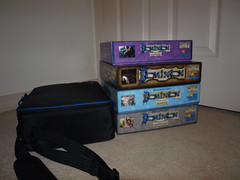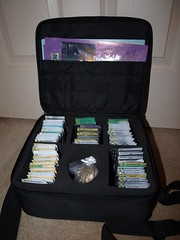A while back I read a
thread on EN World (not a forum I frequent, but the thread was linked off
another blog that I do), I decided that it would be a good idea to do a run down of the local retail gaming establishments. Then I promptly procrastinated. It turned out that I wasn't the only one thinking along these lines, as Liz created a
Google Map showing local stores for the NWARPG forums, which eventually caused me to stop procrastinating and actually finish this "store tour" idea.
The problem with doing what the guys on EN World were doing is that I'm cheap and lazy and don't really feel like driving around to the various stores in the area just to write up a blog post, so instead I'm going to go by memory with a dash of rumor thrown in. Not ideal, but better than nothing, and I suspect that after I post this, I may end up getting more information. Also, since there's only really one "true" game store in the area, I'm going to include all the stores that I'm aware of that carry at least some hobby games.
Barnes & Noble: First on the list because it begins with "B". There are two locations in Northwest Arkansas, one in Fayetteville, and one in Rogers. They generally carry a number of RPG books, mostly D&D with a handful of other titles. The one in Fayetteville had some Shadowrun books, and some Dark Heresy books the last time I checked. It's been well over a year now since I've been to the one in Rogers, but they had a similar selection back then. The Fayetteville store now has a permanent board game section (as opposed to the seasonal section it had in the past), and I imagine that the one in Rogers may as well. It's mostly full of dreck like Monopoly variants, but has a handful of good games as well.
Castle House Hobbies & Games: Next up in alphabetical order is the only "true" game store currently in Northwest Arkansas. Located in Fayetteville, this store carries board games, miniatures games, card games and roleplaying games. It has the best selection in Northwest Arkansas, but that's not to say there isn't room for improvement. I wish there was a bit more selection in some areas, but it's still one of the best to ever grace the region. They do have the largest gaming area in Northwest Arkansas and are fairly free with its use as long as it doesn't interfere with a scheduled event. They have several such events that run there, including regular ones for CCGs and the Boardgame Night I run, as well as several RPG groups that meet there regularly, and periodic Warhammer 40K tournaments.
Dickson Street Used Books: This is an awesome used book store located in Fayetteville, but its connection to gaming is pretty thin. There's often a small selection of used RPGs available here, but it's very hit or miss as to whether or not there's anything worth buying.
Gamer's Utopia: This is a new store that apparently just opened up in the Frisco Station Mall in Rogers. I know nothing about it beyond the fact that they hold Magic tournaments. This may be a second "true" game store, but I don't know yet if that's the case.
Hastings: Another big chain, it's been a couple of years since I visited, but when I did it had a selection comparable to Barnes & Noble, with a bit more variety, as well as a handful of used game books. As something of a historical footnote, this store once carried the full GW line of miniatures and a huge selection of CCGs, but that was well over a decade ago. There are stores in Fayetteville and Springdale.
Rock Bottom Books: This store in Fayetteville is one of the comic shops in Northwest Arkansas. The only reason I included it is that they sell a few CCGs and have a couple of bookcases of used games, mostly RPGs with a few wargames. Prices tend to be a bit high for the used games, but partly as a result of that they usually have a better selection than Dickson Street Used Books.
Tshirt Explosion: I have yet to go to the new location in Springdale, but I have it on reliable authority that it is like the old location in that from the outside there is no indication that this business has anything to do with gaming. On the inside is a large selection of GW product as well as several gaming tables. I'm unsure as to the hours those tables are available. Based on posts I've seen it seems rather hit and miss. The owner runs two annual miniatures tournaments, one for Warhammer Fantasy and one for Warhammer 40K. Both are fairly well attended, drawing quite a few players who make a trip here to play in them (incidentally, Patriot Games, the 40K tournament, is going on as I post this).
Vintage Stock: The other comic store in the area that I'm aware of, Vintage Stock has three locations: Fayetteville, Springdale, and Rogers. Although in the past they had a rather extensive selection of GW merchandise and RPGs, today they only carry CCGs, which is just enough to justify putting them on this list, but not enough to make me a customer.
That's pretty much it. As far as I know, you have to travel at least 120 miles in any given direction to get to another game store, (Springfield, MO; Tulsa, OK; and Russellville, AR being the closest three that I'm aware of).
There's some small possibility that the Hobbytown that recently closed in Bentonville might reopen under new ownership, but that's just rumor at this point, and not very reliable rumor.
2013 Edit: Hastings and Castle House are no more, but in their place we have two new stores:
Gear Gaming in Fayetteville and
Galaxy Games in Springdale.
Both stores have good play areas, but limited selections of merchandise. They are both responsive to their customers' suggestions as to what to stock, so will generally try to have the "new hotness" if it's available and they have been made aware of it.




















